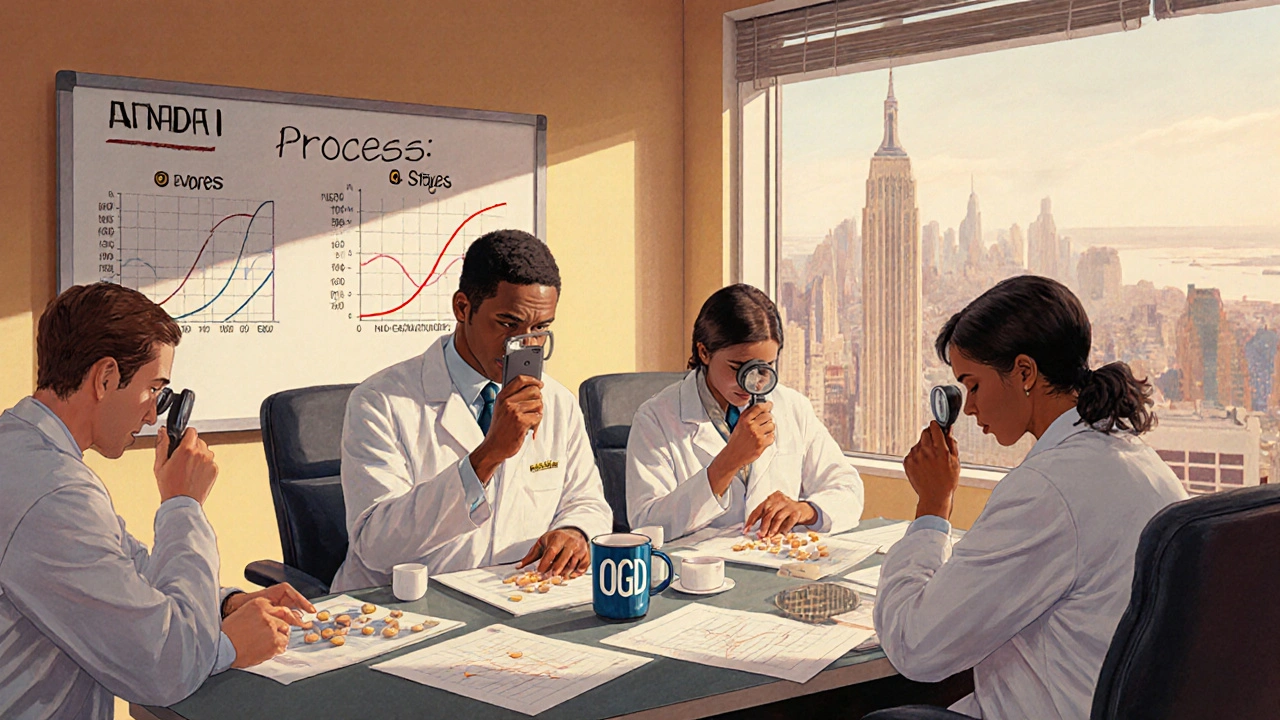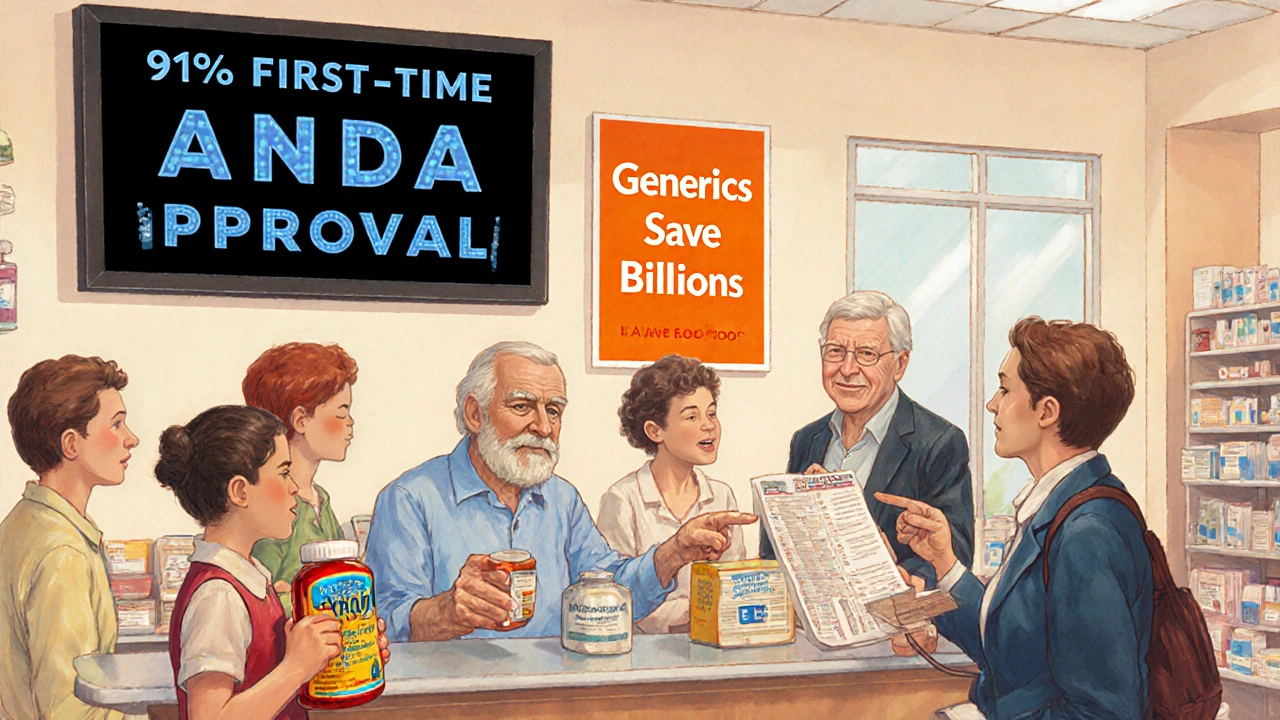FDA’s Abbreviated New Drug Application Process Explained: How Generic Drugs Get Approved

Every time you pick up a prescription and see a lower price tag than the brand-name version, you’re seeing the result of the Abbreviated New Drug Application (ANDA) process. It’s the quiet engine behind 90% of all prescriptions filled in the U.S. - and it’s how generic drugs get approved without repeating every single clinical trial ever done for the original drug.
What Is the ANDA Process, Really?
The ANDA is a shortcut - but not a lazy one. It’s a scientifically strict path created by the Hatch-Waxman Act of 1984 to let generic manufacturers bring affordable versions of brand-name drugs to market. Instead of proving a drug is safe and effective from scratch, generic companies only need to show their version works the same way as the original - the Reference Listed Drug (RLD).
Think of it like baking the same cake using a different bowl and spoon. The ingredients (active drug) must be identical. The recipe (dosage form, strength, how you take it) must match. Even the label (instructions, warnings) has to be nearly the same. The only thing that can be different is the color, shape, or inactive fillers - things that don’t affect how the drug works in your body.
The FDA’s Office of Generic Drugs (OGD) handles this. In 2022, they reviewed over 1,100 original ANDAs and approved 91% of them on the first try. That’s a high bar - and it’s why generics are so reliable.
How Does an ANDA Differ from a Brand-Name Application?
A brand-name drug goes through a New Drug Application (NDA), which requires years of animal testing, multiple phases of human clinical trials, and data on everything from how the drug is absorbed to long-term side effects. The cost? Around $2.3 billion per drug.
An ANDA skips all that. The FDA already knows the RLD is safe and effective. So the generic company only needs to prove bioequivalence - meaning their version releases the same amount of active ingredient into your bloodstream at the same rate as the brand. That’s usually done with a small study in 24-36 healthy volunteers. The entire process costs between $1 million and $5 million.
There’s also a middle path called 505(b)(2), which lets companies tweak existing drugs - like changing the dose or delivery method - and submit new data for those changes. But for a straight copy? ANDA is the only route.
The Four Stages of ANDA Review
Getting an ANDA approved isn’t a one-step process. It’s a four-phase journey:
- Submission and Filing Review - The FDA checks if your application is complete and formatted correctly. If it’s missing key forms like FDA-356h or FDA-3674, or if it’s not submitted electronically via the Electronic Submission Gateway (ESG), it gets bounced back. This step takes up to 60 days.
- Discipline Reviews - Teams of scientists dig into every part: chemistry, manufacturing, bioequivalence, labeling, microbiology. Each team looks for flaws. A single mismatch in tablet hardness or a missing stability study can trigger an Information Request (IR).
- Responses and Revisions - If the FDA finds issues, they send a letter. Most applicants get multiple IRs. One company reported 17 requests across different teams, adding 14 months to their timeline. You have to fix everything - no shortcuts.
- Final Approval or Tentative Approval - If all checks pass and there are no patent or exclusivity blocks, you get Final Approval. If there’s a patent still in effect, you get Tentative Approval. You can’t sell the drug yet, but you’re ready to go the moment the patent expires.
Under GDUFA III (effective 2022), the FDA aims to finish reviewing original ANDAs in 10 months. That’s ambitious. In reality, the average time from submission to approval is about 30 months - mostly because of delays in inspections or complex science.

Why Do So Many ANDAs Get Rejected?
It’s not because generics are unsafe. It’s because the standards are incredibly precise.
According to FDA data from 2022:
- 35% of Complete Response Letters cite inadequate bioequivalence studies - often because the study design didn’t match the RLD’s pharmacokinetics.
- 28% are due to facility issues - manufacturing sites that don’t meet current Good Manufacturing Practices (cGMP).
- 22% involve labeling errors - like missing warnings, wrong dosage instructions, or inconsistent font sizes.
One generic maker spent $1.2 million and three tries to get bioequivalence right for a topical cream. Why? Skin absorption is tricky. The drug has to penetrate at the same rate as the brand, and small changes in emulsifiers or pH can throw it off.
These aren’t mistakes. They’re proof the system works. The FDA doesn’t approve generics because they’re cheap. They approve them because they’re proven to be the same.
Who’s Using the ANDA Process - and Why It Matters
The U.S. generic drug market was worth $127.6 billion in 2022. It’s projected to hit $189.2 billion by 2027. That growth isn’t accidental. It’s because of ANDA.
Big players like Teva, Viatris (formerly Mylan), and Sandoz dominate, but over 75% of ANDAs come from companies that have already approved at least five generic products. Experience matters. One VP at Teva said after their tenth approval, they hit GDUFA timelines 92% of the time.
And the savings? In 2021 alone, generic drugs saved the U.S. healthcare system $373 billion. That’s not a guess - it’s from the IQVIA Institute. For patients, that means a 30-day supply of a generic blood pressure pill might cost $4 instead of $40. For insurers, it means lower premiums. For taxpayers, it means less strain on Medicare and Medicaid.

Challenges in the Modern ANDA Landscape
Not all generics are created equal - and not all ANDAs are easy.
Complex generics - like inhalers, injectables, or topical ointments - are the new frontier. They’re harder to copy because small changes in manufacturing can change how the drug behaves in the body. In 2022, 35% of pending ANDAs were for these complex products. The FDA is investing in new tools, including AI-assisted chemistry reviews, to keep up.
Patents and exclusivity periods still block entry. Even if your drug is perfect, you can’t sell it until the brand’s patent expires - and sometimes, brand companies file multiple patents to delay competition, a tactic called “patent thickets.”
Inspections are another bottleneck. The FDA inspects manufacturing sites globally. If your factory in India or China hasn’t passed inspection, your ANDA sits in limbo. Over 63% of applicants report delays due to inspection backlogs.
And then there’s the human factor. One regulator said: “We’re not trying to stop generics. We’re trying to make sure they’re as good as the brand.” That mindset shapes every decision.
What You Can Do If You’re a Patient
You don’t need to understand the ANDA process to benefit from it. But knowing a few things helps:
- Ask your pharmacist if a generic is available. It’s almost always an option.
- Generics are not “weaker” or “inferior.” They contain the same active ingredient, in the same dose, with the same effect.
- If you notice a difference in how a generic works for you, talk to your doctor. Rarely, inactive ingredients (like dyes or fillers) can cause reactions - but the drug itself is identical.
- Generic drugs are often made in the same factories as brand-name drugs. The FDA inspects them all the same way.
There’s no reason to pay more unless you have a specific medical need. For most people, the generic is the smarter, safer, and more affordable choice.
The Future of Generic Drugs
The ANDA process isn’t frozen in time. It’s evolving. The FDA’s 2022-2026 Strategic Plan includes:
- Using real-world data to support approvals for complex generics.
- Harmonizing standards with global regulators through the ICH.
- Expanding product-specific guidances - they’ve published 450 new ones in 2022 alone.
- Improving inspection efficiency with better risk-based models.
AI is already helping FDA reviewers analyze chemistry data faster. In 2023, 78% of reviewers used AI tools to spot inconsistencies in manufacturing data. That means fewer delays - and more generics hitting the market sooner.
But the biggest threat isn’t science. It’s policy. If patent laws get tighter, or if the FDA’s funding gets cut, the pipeline slows. That’s when drug prices creep back up.
For now, the ANDA process remains one of the most successful public health tools in modern medicine. It balances innovation with access. It rewards companies that can replicate science precisely. And it puts billions back into patients’ pockets every year.
Is a generic drug the same as the brand-name version?
Yes, in every way that matters. Generic drugs contain the same active ingredient, in the same strength, dosage form, and route of administration. They must meet the FDA’s strict bioequivalence standards, meaning they work the same way in your body. The only differences are in inactive ingredients - like color, shape, or fillers - which don’t affect how the drug works.
Why are generic drugs so much cheaper?
Generic manufacturers don’t have to repeat expensive clinical trials. They rely on the FDA’s prior approval of the brand-name drug, which saves them millions. Their costs are mostly in manufacturing and regulatory paperwork - not research. That’s why generics typically cost 80-85% less than brand-name drugs.
Are generic drugs made in the same facilities as brand-name drugs?
Often, yes. Many brand-name companies also make generic versions of their own drugs. The FDA inspects all manufacturing sites - whether they make brand or generic - under the same standards. In fact, about half of all generic drugs are produced by companies that also make brand-name drugs.
What does ‘tentative approval’ mean?
Tentative approval means your generic drug meets all scientific and safety requirements, but you can’t sell it yet. This usually happens because a patent or exclusivity period for the brand-name drug hasn’t expired. Once that protection ends, the FDA grants final approval and you can start selling.
How long does it take to get an ANDA approved?
The FDA’s goal is 10 months for original ANDAs under GDUFA III. But in practice, it takes about 30 months on average. Delays come from inspection backlogs, complex science (like topical or injectable drugs), or multiple rounds of requests from the FDA. Companies with experience usually get approvals faster.
Can I trust a generic drug if it looks different from the brand?
Absolutely. By law, generics can look different - different color, shape, or imprint - to avoid trademark issues. But the active ingredient, dose, and how it works in your body must be identical. If you’re concerned, ask your pharmacist for the FDA’s list of approved generics. All approved generics are listed in the Orange Book.
What happens if a generic drug doesn’t work for me?
It’s rare, but possible. Sometimes, inactive ingredients (like dyes or preservatives) can cause mild reactions in sensitive individuals. If you notice side effects or feel the drug isn’t working as well, talk to your doctor. They may switch you to another generic or the brand. But in most cases, the issue isn’t the active ingredient - it’s something else, like dosage timing or another medication you’re taking.
Generic drugs aren’t a compromise. They’re a triumph of science, regulation, and competition. The ANDA process ensures that life-saving medications stay affordable without sacrificing safety. And for millions of people, that’s the difference between taking their medicine - and skipping it.